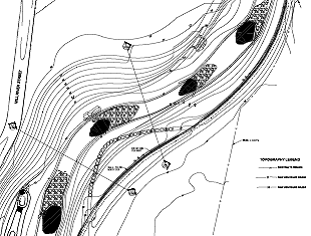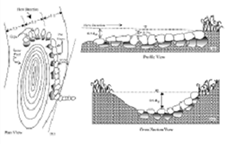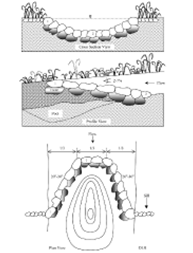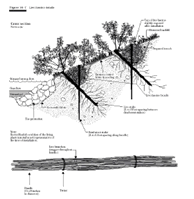Over the years the Dam and walls of the Mill Pond had deteriorated and the pond became degraded due to accumulated sediment. The river restoration will be undertaken by the City in conjunction with the Army Corps of Engineers. It involves the removal of the dam and concrete walls and the excavation of a wider flood plain within the park.
The new river channel will be constructed as a series of stone riffles and pools that replicate the structure of Mill River in its upstream reaches. These pools and riffles will also provide access for migratory fish to climb upstream to fresh water where they spawn. River Herring, including alewife and blueback herring will be the principal beneficiaries of the additional 4+ miles of spawning habitat that will be created by the removal of the Mill Pond dam. These species have suffered dramatic declines along the Connecticut coast. They are important feed stocks for striped bass, popular sport fish, whose numbers are rebounding dramatically following a near collapse in the 1970s and 1980s. Eels will also benefit from the new freedom to move between Long Island Sound and fresh water upstream in the river. |
 |
 |
| |
|
|
The Army Corps of Engineers participation in the project is authorized under the Corps’ Section 206 Habitat Restoration Program. Corps participation and funding is predicated n improving and restoring habitat for native species. The areas along the river will be regarded and planted with native plants and trees, particularly in the riparian zone, where the land and aquatic ecosystems interact. For example, insects that eat vegetation or hatch on trees along the river, serve as food for fish and other aquatic wildlife. New trees along the banks will also offer shade over the water keeping temperatures cool enough for fish year round. |
| |
New techniques will be used to reconstruct the river channel. Historically, on Army Corps projects, a lot of rock is laid along the banks to protect them from erosion. In the Mill River restoration, the use of rock will occur mostly within the river channel to create rock vanes and J-hooks.
These rock structures are higher in elevation near the banks than they are in the middle of the river. As water moves over them, gravity pulls the water along the banks back toward the center of the channel reducing the eroding force of the water against the banks. |
|

J-Hook |
| |
|
|
| On the stream edge, the banks will be stabilized primarily with vegetation using certain bioengineering techniques such as live stakes and fascines.
An abandoned dam structure under the Pulaski Street Bridge will be lowered to allow fish to pass it during the majority of the tide cycle.
The river restoration also involves restoration of tidal wetlands at two locations near the mouth of the river where an invasive reed called phragmites, have taken over.
These areas will be excavated so they are below water most of the time and replanted with marsh grasses such as spartina that will provide an environment conducive to aquatic life.
|
 |

Cross-Vein |
|
| |

Live Fascines |
 |

Live Stakes |
|
|